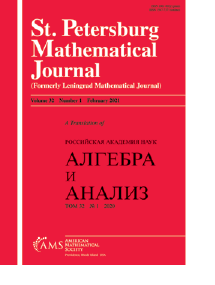Scattering by magnetic fields
HTML articles powered by AMS MathViewer
- by
D. R. Yafaev
Translated by: the author - St. Petersburg Math. J. 17 (2006), 875-895
- DOI: https://doi.org/10.1090/S1061-0022-06-00934-4
- Published electronically: July 27, 2006
- PDF | Request permission
Abstract:
Consider the scattering amplitude $s(\omega ,\omega ^\prime ;\lambda )$, $\omega ,\omega ^\prime \in {\mathbb S}^{d-1}$, $\lambda > 0$, corresponding to an arbitrary short-range magnetic field $B(x)$, $x\in {\mathbb R}^d$. This is a smooth function of $\omega$ and $\omega ^\prime$ away from the diagonal $\omega =\omega ^\prime$, but it may be singular on the diagonal. If $d=2$, then the singular part of the scattering amplitude (for example, in the transversal gauge) is a linear combination of the Dirac $\delta$-function and a singular denominator. Such a structure is typical of the long-range magnetic scattering. This phenomenon is referred to as the long-range Aharonov–Bohm effect. On the contrary, for $d=3$ scattering is essentially of a short-range nature, although, for example, the magnetic potential $A^{\mathrm {(tr)}}(x)$ such that $\operatorname {curl} A^{\mathrm {(tr)}}(x)=B(x)$ and $\langle A^{\mathrm {(tr)}}(x),x\rangle =0$, decays at infinity as $|x|^{-1}$ only. More precisely, it is shown that, up to the diagonal Dirac function (times an explicit function of $\omega$), the scattering amplitude has only a weak singularity in the forward direction $\omega = \omega ^\prime$. The approach is based on the construction (in the dimension $d=3$) of a short-range magnetic potential $A (x)$ corresponding to a given short-range magnetic field $B(x)$.References
- G. N. Afanasiev, Topological effects in quantum mechanics, Fundamental Theories of Physics, vol. 107, Kluwer Academic Publishers Group, Dordrecht, 1999. MR 1730630, DOI 10.1007/978-94-011-4639-5
- Y. Aharonov and D. Bohm, Significance of electromagnetic potentials in the quantum theory, Phys. Rev. (2) 115 (1959), 485–491. MR 110458
- Rainer Hempel and Ira Herbst, Strong magnetic fields, Dirichlet boundaries, and spectral gaps, Comm. Math. Phys. 169 (1995), no. 2, 237–259. MR 1329195
- Walter C. Henneberger, Some aspects of the Aharonov-Bohm effect, Phys. Rev. A (3) 22 (1980), no. 4, 1383–1388. MR 587271, DOI 10.1103/PhysRevA.22.1383
- Ira W. Herbst, On the connectedness structure of the Coulomb $S$-matrix, Comm. Math. Phys. 35 (1974), 181–191. MR 351325
- Michael Loss and Bernd Thaller, Scattering of particles by long-range magnetic fields, Ann. Physics 176 (1987), no. 1, 159–180. MR 893482, DOI 10.1016/0003-4916(87)90182-5
- M. Peshkin and A. Tonomura, The Aharonov-Bohm effect, Lecture Notes in Physics, vol. 340, Springer-Verlag, Berlin, 1989. MR 1016149, DOI 10.1007/BFb0032076
- P. Roux, La matrice de diffusion pour l’opérateur de Schrödinger avec un potentiel électro- magnétique à longue portée, Ph. D. thesis, Univ. de Rennes-1, 2001.
- Ph. Roux and D. Yafaev, On the mathematical theory of the Aharonov-Bohm effect, J. Phys. A 35 (2002), no. 34, 7481–7492. MR 1945524, DOI 10.1088/0305-4470/35/34/316
- Ph. Roux and D. Yafaev, The scattering matrix for the Schrödinger operator with a long-range electromagnetic potential, J. Math. Phys. 44 (2003), no. 7, 2762–2786. MR 1982788, DOI 10.1063/1.1576494
- S. N. M. Ruijsenaars, The Aharonov-Bohm effect and scattering theory, Ann. Physics 146 (1983), no. 1, 1–34. MR 701261, DOI 10.1016/0003-4916(83)90051-9
- M. A. Šubin, Psevdodifferentsial′nye operatory i spektral′naya teoriya, “Nauka”, Moscow, 1978 (Russian). MR 509034
- D. Yafaev, On the classical and quantum Coulomb scattering, J. Phys. A 30 (1997), no. 19, 6981–6992. MR 1481360, DOI 10.1088/0305-4470/30/19/032
- Dmitri Yafaev, Scattering theory: some old and new problems, Lecture Notes in Mathematics, vol. 1735, Springer-Verlag, Berlin, 2000. MR 1774673, DOI 10.1007/BFb0105531
- D. Yafaev, High-energy and smoothness asymptotic expansion of the scattering amplitude, J. Funct. Anal. 202 (2003), no. 2, 526–570. MR 1990537, DOI 10.1016/S0022-1236(02)00077-0
- D. R. Yafaev, Scattering matrix for magnetic potentials with Coulomb decay at infinity, Integral Equations Operator Theory 47 (2003), no. 2, 217–249. MR 2002666, DOI 10.1007/s00020-003-1160-0
Bibliographic Information
- D. R. Yafaev
- Affiliation: IRMAR, Université Rennes-I, Campus Beaulieu, 35042 Rennes Cedex, France
- Email: yafaev@univ-rennes1.fr
- Received by editor(s): January 20, 2005
- Published electronically: July 27, 2006
- © Copyright 2006 American Mathematical Society
- Journal: St. Petersburg Math. J. 17 (2006), 875-895
- MSC (2000): Primary 47A40, 81U05
- DOI: https://doi.org/10.1090/S1061-0022-06-00934-4
- MathSciNet review: 2241430
Dedicated: Dedicated to the memory of Ol $^\prime$ga Aleksandrovna Ladyzhenskaya


